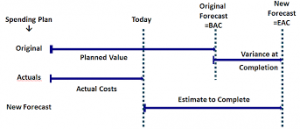When a project is ongoing, you must monitor the health of the project whether the project is on budget, on time and quality requirements are met. Earned value management and earned value formula technique are some of the ways to analyze actual results vs planned values. We will go over these concepts in detail in our post.
What is Earned Value Management?
Earned value management is a project management technique for measuring project performance and progress. It has the ability to combine measurements of the project management triangle: scope, time, and costs. In a single integrated system, earned value management system is able to provide accurate forecasts of project performance problems, which is an important contribution to project management.
Earned value EV analysis is a critical tool and technique for Project Cost Management. It is very crucial to understand in order to appear for the Project Management Professional (PMP) exam. The reason is that a lot of numerical questions are based on the earned value EV formula in the PMP PMI exam. When you use the earned value formula, you are measuring and analyzing how far off your project is from your plan and this helps you to measure the performance of project management processes. If you get a good hold of concepts and earned value formula, then it gives you the advantage to pass the exam in the first go.
Attend our 100% Online & Self-Paced One-Hour Free PMP Training.
Supposedly, the Project Manager is managing a project. Generally, customer or senior management asks a very common question. And the question is how is your project going? In traditional project management, project managers use the technique of plotting graphs. The graph describes the planned cost against the actual cost incurred. However, this technique doesn’t tell about the health of the project. As there could be a scenario where the project team has accomplished the planned work but with more cost incurred? Or the team is behind schedule though the cost is less spent on the project. Hence it doesn’t provide sufficient information to communicate about the health of the project or answer the question of how the project is going.
Project Management presents many tools and techniques for the management of a successful project. One of the most regarded of these tools is Earned Value Analysis.
Earned Value Analysis with Earned Value Formula
It is a project management technique for evaluating project performance. Predicting final project results based on comparing the progress to planned work and project budget to the actual cost incurred. Earned value management gives an opportunity to look at the scope, schedule, and cost performance in one unit of measurement i.e. any currency like dollars.
Watch our “What are the PMP® formulas and Earned Value Formulas?” video
This article will explain the terminologies, earned value formulas, and key metrics used to monitor in earned value analysis. Last but not least, we will be listing the tips and tricks to remembering the earned value formula. You can attend our 99.6% first-attempt pass rate PMP training and learn all PMP exam content to clear the PMP exam on your 1st attempt.
Why do we need Earned Value Management (EVM)?
Earned Value Management is used in performance reviews to measure project performance against scope, schedule, and cost baselines. It is a project management technique for estimating how a project is doing in terms of its budget and schedule
As mentioned above, Earned Value management helps the project manager to answer the 3 following questions related to the project:
- Where have we been?
- Where are we now?
- And where are we going?
In Earned Value Management, there are three data sources related to the project:
- the budget (or planned) value of work scheduled i.e. PV
- The actual value of work completed i.e. AC
- the “earned value” of the physical work completed i.e. EV
Earned Value takes these three data sources. It compares the budgeted value of work scheduled with the “earned value of physical work completed” and the actual value of work completed. It integrates cost, time and work done (Scope) and uses them to forecast future performance and project completion dates and costs.
After helping over 125,000 professionals in more than 180 countries with a 99.6% first attempt pass rate, we have prepared a seven-step PMP study plan. Read this PMP study plan and create your own best PMP exam prep plan accordingly.
Earned Value Definitions
Earned value analysis uses three key pieces of project information: the planned value, actual cost, and earned value, which are shown in the below diagram.

Scenario: Supposedly, you are allocated a website project management work with the budget at $200,000. And the project is to install antivirus software on 1000 computers in an organization in 10 days. On the 3rd day, you found that antivirus software was installed on 350 computers. The cost that has been spent on the project as of date is $65,000. As a project manager, you have to provide the status of the project to senior management.
We will give examples and scenarios over this project example to teach you earned value formula concept better.
Earned Value Formula #1 – Budget at Completion (BAC)
It is defined as the total budget you have been allocated for the project. This is the planned cost required to complete the entire work or total project work. In simple terms, it is defined as the Original Budget for the total project effort. That means how much you plan to spend on your project.
Here BAC is $200,000
Earned Value Formula #2 – Planned Value (PV)
Planned Value PV is defined as the budgeted cost for work planned to be done. This is also known as BCWS. In simple terms, as of today, what is the estimated value of the work planned to be done.
Formula is PV= BAC * Planned % Complete
Where Planned % Complete= Given Amount/Total Amount.
Here Planned % Complete=300/1000=30%
Hence PV = 30%*$200,000=$60,000
Earned Value Formula #3 – Actual Cost (AC)
Actual Costs AC is defined as the money spent on the work accomplished. This is also known as the actual cost of work performed (ACWP). In other words, it is the amount you have actually spent on the project. It can be described as the actual cost incurred for the work accomplished.
Here the value of actual cost AC =$65,000
EV Formula #4 – Earned Value (EV)
Earned Value (EV) is the percent of the total budget actually completed at a point in time. This is also known as the budgeted cost of work performed BCWP. In other words, earned value is about how much work you have been able to accomplish with the money you have been given. It is not the cost of work completed. Rather it is the value of work completed as per the original budget. EV is calculated by multiplying the budget for an activity or work package by the percentage progress:
The formula is Earned Value (EV) = Actual % Complete x Budget at completion (BAC)
Where Actual % Complete= Actual Amount/Total Amount.
Here Actual % Complete=350/1000=35%
Hence, Earned Value (EV) =35%*$200,000=$70,000
Generally, in a small project, figuring out if you are on track is easy. But in a large project with dozen of activities, some activities are on track, some activities are ahead of schedule and some of them are behind schedule. Hence it is difficult to figure out whether the project is on track or not. That’s where earned value formula comes into the picture.
Earned Value Formula #5 – Schedule Performance Index (SPI)
Schedule Performance Index SPI: It is used to determine whether you are ahead of or behind the schedule. SPI is calculated by dividing EV by PV
Schedule Performance Index (SPI) =EV/PV
Here SPI =$70,000/$60,000= 1.16
If SPI >1, that means EV > PV so you are ahead of schedule because the amount you have actually worked (EV) is more than what you had planned (PV).
If SPI <1, that means EV<PV so you are behind the schedule because the amount you have actually worked (EV) is less than what you had planned (PV)
Always remember that SPI greater than 1 is good whereas SPI lesser than 1 is bad.
Earned Value Formula #6 – Schedule Variance (SV)
Schedule Variance SV is the difference between what you planned and what you actually earned.
SV=EV-PV
Here SV=$70,000-$60,000 =$10,000
Always remember for the sponsor’s benefit, it is measured in dollars or any currency.
If the variance is +ve, it tells you how many dollars you are ahead of schedule.
If the variance is –ve, it tells you how many dollars you are behind the schedule
Earned Value Formula #7 – Cost Performance Index (CPI)
Cost Performance Index CPI: It is used to determine whether you are over or under the budget. This is calculated by dividing EV by AC.
Cost Performance Index (CPI) =EV/AC
Here CPI =$70,000/$65000 =1.076
If CPI >1, that means EV > AC so you are under budget
If CPI <1, that means EV< AC so you are over budget.
Always remember CPI greater than 1 is good whereas CPI lesser than 1 is bad.
Earned Value Formula #8 – Cost Variance (CV)
Cost Variance CV is the difference between what you planned and what you actually earned.
CV=EV-AC where EV measures the work that has been done. And AC tells how much you have spent so far.
Here CV=$70,000-$65,000=$5000
Always remember for the sponsor’s benefit, it is measured in dollars or any currency.
If CPI >=1 or CV is greater than zero, that means you are within budget. Because your actual costs are less than the earned value. Hence the project is delivering more value than its cost.
If CPI <1 and CV is less than zero, that means you have blown your budget. Because when your actual costs are more than the earned value that means the sponsor is not getting his money’s worth of value from the project.
If CPI is really close to 1, that means every dollar your sponsor is spending on the project is earning just about a dollar in value.
In a nutshell, If CPI or SPI is below 1 or if CV or SV is negative, then you’ve got trouble.
Forecasting: It is another tool and technique in Project Cost Management. The idea behind forecasting is that you can use earned value to come up with a pretty accurate prediction of what your project will look like at completion.

EV Formula #9 – Estimate at Completion (EAC)
Estimate at Completion EAC defines as of now, how much we expect the total project to cost. It is the revised estimated budget for the entire work.
Scenario: You are a contractor who is involved in the renovation of a housing project. Duration is 5 months. The Original Budget (BAC) is $15,000 and you have completed 40% of the work. And this is the 3rd month going on. CPI is 0.67 which indicates that you are running over budget, SPI is 0.66 which means you are running behind schedule and AC is $9,000.
There are many ways to calculate EAC, depending upon the assumptions made as follows:
Assuming that the original estimate was fundamentally flawed.
This formula calculates the actual cost to date plus a new estimate for the remaining work
EAC =AC +Bottom up ETC
Where ETC is the amount of money needed to complete the remaining work.
Here you will ask your team to go to the activity level, find the cost of each activity and sum them to get a new estimate to complete the remaining work i.e. (new ETC). It will be further added to the actual costs (money already spent) to determine EAC.
Assuming that no variances from Budget at Completion BAC have occurred or you will continue at the same rate of spending:
(As calculated in cumulative CPI or based on trends that have led to current CPI). This formula is used in the above-described condition.
EAC=BAC/CPI
In the above scenario, the situation is that you found out that the technical staff that is being used is much more expensive than you originally estimated. This would be considered a typical variance. And it is going to continue to affect the project.
Hence EAC =BAC/CPI =$15,000/0.67 =$22,388
Assuming that current variances are thought to be atypical (one-time variance) of the future.
Due to some unforeseen or one-time condition, the cost has increased. This will not happen again so you can continue with the planned cost.
This earned value formula calculates actual costs to date plus the remaining budget. It is essentially AC plus the remaining value of work to perform.
EAC= AC + (BAC-EV)
In the above scenario, the situation is that the contractor found marks and dents in the plywood to be used and need to change the entire plywood. It causes time variance. Here you could use atypical earned value formula i.e.
EAC= $9,000+$15,000-$6,000=$18,000
Assuming that current variances are thought to be typical of future and project schedule constraints will influence the completion of the remaining effort.
Here Typical of future means you have encountered a variance that is expected to recur and continue to affect the project. In other words, this is a typical scenario that impacted both cost and schedule variations. Current variations of cost and schedule are going to continue at the current CPI and SPI rates. Then you need to factor the variance in the initial budget by adjusting the budget based on the variance from the remaining duration.
This earned value formula calculates actual to date plus the remaining budget modified by performance:
EAC= AC+ (BAC-EV)/ (CPI*SPI)
In the above scenario, the situation is that due to the festival season, labor is not available, and thereby, labor cost, and availability of labor duration will also be fluctuating. Hence it will have schedule constraints and will impact CPI as well.
Hence EAC =$9,000+ ($15,000-$6,000)/ (0.67*0.66) =$9000+ 20362=$29362

Earned Value Formula #10 – Estimate to Complete (ETC)
Estimate to Complete defines how much more money you will probably spend on your project. In other words, how much more will the project cost? It is calculated by subtracting AC from EAC.
ETC =EAC-AC where EAC predicts how much money you will spend.
Another way to find ETC is to re-estimate the remaining work from the bottom up.
In case of typical variance
The situation is that you found out that the technical staff that is being used are much more expensive than you originally estimated. This would be considered a typical variance and it is going to continue to affect the project.
Hence ETC =EAC-AC = $22,388- $9,000 =$13,388
In the case of atypical variance
The situation is that the contractor found many marks and dents in the plywood to be used and need to change the entire plywood. It has caused a one-time variance. Here you could use the atypical earned value formula:
Hence ETC= EAC-AC =$18,000-$9,000=$9,000
EV Formula #11 –Variance at Completion (VAC)
Variance at Completion defines how much over or under budget will you be at the end of the project? It is calculated by subtracting Estimate at Completion (EAC) from Budget at Completion BAC
Hence VAC=BAC-EAC
Here VAC= $15,000-22,388 =-$7,388 assuming EAC to be calculated based on the typical of future situation
If VAC is negative that means you end up spending more than your budget.
If VAC is positive that means you spent less than your budget.

Earned Value Formula #12 –To Complete Performance Index (TCPI)
To Complete Performance Index TCPI provides a forecast of the required performance level which must be achieved on the remaining work in order to meet the project’s financial goal.
In other words, it is used to determine whether you are on target. Also, it helps to determine where you need to be to make sure you get things done with the budget you have.
This PMP earned value formula divides the work remaining to be done by the money remaining to do it.
TCPI= (BAC-EV)/ (BAC-AC)
In order to stay within budget, what rate must we meet for the remaining work?
There are 2 different formulas to calculate TCPI:-
When you are trying to get your project within the original budget or approved budget i.e. BAC
TCPI = (BAC-EV)/ (BAC-AC)
When you are trying to get your project within EAC (newly approved budget) you have determined from PMP earned value formula calculations.
TCPI = (BAC-EV)/ (EAC-AC)
Where (BAC-EV) = how much-budgeted work is left and
(BAC-AC) =how much-budgeted money is left.
Here TCPI = ($15,000-$6,000)/ ($22,388-$9,000) = (9,000/13,388) =0.672
assuming EAC is calculated based on a typical of future situation
If TCPI >1 then it means it is less likely to complete the project on the forecasted budget.
And TCPI < 1, then it means it is more likely to complete the project on the forecasted budget.
Tips and Tricks to remember the formulas
- Always remember that EV comes first in each of the formulas of CV, SV, CPI, and SPI
- If it is a variance then the formula is EV minus AC or PV
- In case, it is a ratio then the formula is EV divided by PV or AC
- And if the formula relates to schedule, then use PV
- If the formula relates to cost, then use AC
- For interpretation of variances: Positive is Good and Negative is Bad
- Interpretation of indexes of CPI and SPI: Greater than 1 is good and Less than 1 is bad.
- For interpretation of the index of TCPI: Greater than 1 is Bad and Less than 1 is Good.
Earned Value Management EVM – Summary
There is a compiled list of all the PMP earned value formulas including earned value formulas and a cheat sheet required for the PMP exam prep. You can also download the formulas by clicking this link: PMP formulas. It is the most comprehensive cheat sheet based on PMBOK 6th edition. This contains 15 earned value formulas with the description which will help you for the best PMP exam prep.



